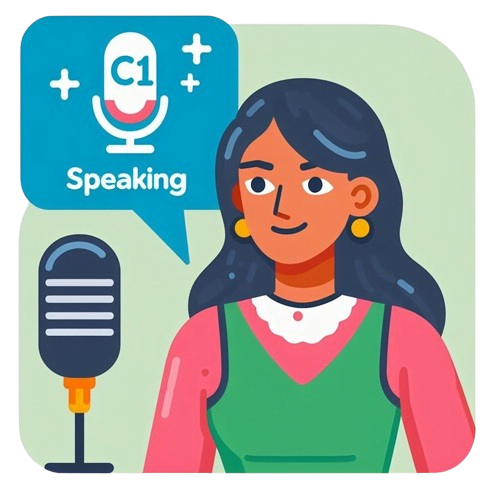Cambridge C1 (CAE): Reading and Use of English Part 1

Key Points
- Part 1 of the Reading and Use of English paper is a multiple-choice cloze test that evaluates vocabulary and grammar through understanding and context.
- Effective strategies for Part 1 include understanding sentence context, identifying subtle differences among answer choices, eliminating incorrect options, and thorough vocabulary study, focusing on collocations and shades of meaning.
What you will find in this guide:
Reading and Use of English Part 1
The Cambridge C1 (CAE) is a high-level English language exam, recognized by universities and employers across the globe. It’s designed to assess your ability to use English in real-life situations, and the Reading and Use of English section is a crucial part of this assessment21.
In this guide, we’ll be focusing on Part 1 of the Reading and Use of English paper2. This part of the exam tests your understanding of vocabulary and grammar in a multiple-choice cloze test format34. It’s a challenging section, but with the right strategies and plenty of practice, you can master it21.
We’ll be covering everything from understanding the test format, to providing strategies and tips, and reviewing practice tests3421. Our aim is to give you a well-rounded understanding of the “Cambridge C1 (CAE) Reading and Use of English Part 1” and equip you with the knowledge and skills to excel in this part of the exam.
Part 1 consists of a text in which there are eight gaps. Each gap represents a missing word or phrase. There are four options to choose from. The options corresponding to each gap will appear when you click on the gap in the digital test. They will be to the right of the text in the paper-based test.
Candidates have to choose which one of the four words or phrases fills the gap correctly.
Candidates are required to draw on their lexical knowledge and understanding of the text in order to fill the gaps. Some questions test at a phrasal level, such as collocations and set phrases. Other questions test meaning at sentence level or beyond, with more processing of the text required. A lexico-grammatical element may be involved, such as when candidates have to choose the option which fits correctly with a following preposition or verb form.
The Structure of Part 1
Now that we’ve covered the basics, let’s dive into the specifics of the “Cambridge C1 (CAE) Reading and Use of English Part 1” format.
The Reading and Use of English (RUE) has 8 parts, and takes 90 minutes. You will need to answer questions using your knowledge of English grammar and vocabulary, and answer various reading questions. Here’s a complete overview of the different parts of the RUE paper.
- Part 1 – Multiple-choice cloze
- Part 2 – Open cloze
- Part 3 – Word formation
- Part 4 – Key word transformations
- Part 5 – text with multiple-choice questions
- Part 6 – Cross-text multiple matching
- Part 7 – text with paragraphs missing
- Part 8 – Multiple matching5
However, Part 1 of the reading and use of English paper is known as the “Multiple-choice cloze” test5. In this part of the exam, you will be presented with a text in which there are eight gaps4. Each gap represents a missing word or phrase4. The text is followed by eight lists of four words or phrases, each list is assigned to a gap4. Your task is to choose which word or phrase in the set fills the gap correctly4.
This might sound straightforward, but it can be quite challenging because the test is designed to assess your understanding of vocabulary and grammar35. Therefore, it’s not just about knowing the meanings of words, but also about understanding how they are used in context35.
Sample Question

Potential Challenges
The Cambridge C1 Advanced (CAE) reading and use of English part 1 is perhaps the easiest part of the reading paper! However, there may be some potential Challenges when taking this part. Knowing these challenges can help you prepare better and make sure you will have a plan to overcome them. So, we will go over the challenges of part 1 in this part of the guide.
Some potential Challenges may include:
1- Similar Vocabulary Issue: As you know, you will get a text with some blanks to fill out, and you will get some words as options to choose from. The options however, are very similar to each other in meaning. This could be a bit confusing for some candidates and may lead to the wrong choice if you’re not good at vocabulary.
2- The Grammar Issue: Sometimes, some options you have don’t make grammatical sense! What I mean is that one option may have the right meaning to be used in a sentence but be grammatically incorrect once used in that sentence. So, you have to pay especial attention to the grammatical considerations too.
Guide to Part 1
Part 1, the cloze test, tests your ability to use English vocabulary effectively. So, please consider the following:
Step 1:
Make sure to understand what the sentence containing the blank means and tries to imply. This is vital because you need to complete the idea expressed in that sentence.
Step 2:
Read the answer choices to see what options you have.
Step 3:
Identify the meaning of the options and try to find slight differences among the options you have. You usually get similar words that slightly differ in meaning. So, you should know how the meaning of the sentences changes based on the word (options) you choose.
Step 4:
Remove two answer choices that you think do not match the meaning of the sentence you are reading. Removing two options that clearly don’t match the sentence increases your chance of getting the answer correct by 50%.
Step 5:
Use your knowledge, logic, and reasoning skills to chose the correct option from the two remaining answer choices.
Step 6:
Read the next sentence to see if the two ideas complement each other, and that to see if they match with the word you used in the sentence.
Important tips
- Study English vocabulary as much as possible. Since this part tests your vocabulary knowledge, your job actually starts before you take the test, so you need to focus on studying a range of common and uncommon words and being able to distinguish fine differences among words with similar meaning.
- Pay close attention to collocations, meaning if the word used in the text collocates with the option you have in the answer sheet.
- Pay close attention to different shades of meaning within sets of similar words. Words often have different meanings so you need to be careful.
- Pay close attention to the right part of speech.
- Pay close attention to complementation (e.g. whether words are followed by a certain preposition, or by a gerund or an infinitive, etc.).
- Make sure to consider all the options carefully before deciding on an answer. Some of the options may be very tempting, but only one will be semantically and grammatically correct.
Practice test
Use the guide to practice reading and use of English part 1 using the following sample test.
Three theories about sleep
People spend about one-third of their lives asleep. It seems certain ,therefore, that sleep has a (O) VITAL function. However, what that function might be is still in (1) ……………….. Scientists are far from being in agreement about (2) ……………….. why so much of our precious time is given over to sleep. There seem to be three main theories. The most popular states that the functions and (3) .. of sleep are primarily physiological. It claims that we sleep in order to (4) ……………….. the health of our body. In other words, biological processes work hard as we sleep to repair any damage done during the day and to restore ourselves to (5) ……………….. efficiency. However, a second theory places more emphasis on the learning benefits of sleep. This theory holds that sleep allows us to process the information that we (6) ……………….. during the day, and asserts that , without sleep, learning would not take place. A third popular theory is (7) ……………….. on ideas about energy, saying that we need (8) ……………….. of sleep in order to, in a sense, recharge our batteries and so have an adequate supply of energy for the coming day.
- A) discussion B) dispute C) argument D) debate
- A) correctly B) absolutely C) actually D) precisely
- A) purposes B) targets C) intentions D) points
- A) take B) maintain C) stay D) keep
- A) strong B) utter C) full D) entire
- A) achieve B) complete C) reach D) acquire
- A) rooted B) supported C) based D) developed
- A) periods B) eras C) moments D) episodes
References
- Cambridge C1 Advanced (CAE): Reading and Use of English Part 1 – Teacher Phill
- Passing Cambridge C1 Advanced – Part 1 Reading and Use of English | Oxford House Barcelona (oxfordhousebcn.com)
- Practice tests for CAE Reading and Use of English (Cambridge English: Advanced) (flo-joe.co.uk)
- CAE Reading and Use of English Practice Tests – EngExam.info
- C1 Advanced exam format | Cambridge English
How was your experience?
Describe your experience taking the C1 Advanced (CAE) reading and use of English part 1 in the comment section below.







Part one was easier than part two since in part one you could differentiate words by their meaning and context, however part two is more complex due to the similarity of the options
I learned new words and how they are used, I consider that now I am clear when to add words to the ones we have just seen, I hope to be able to practice this part of the test next time
The pictures are too small it is hard to read clearly.
My eyes hurt. :c
Pdt the second one was easier!
It was a very confusing but informative and useful class, since in the parte 1 now we have more guiding ideas to solve that.
It has been a very informative lesson. A bit frustrating beacuse I had a difficult time explaining my reasons why I thought my answers were correct. But over all a great experience.